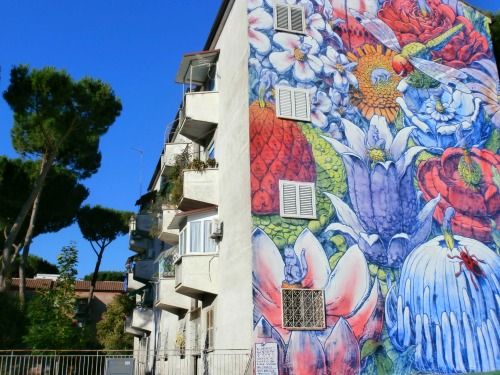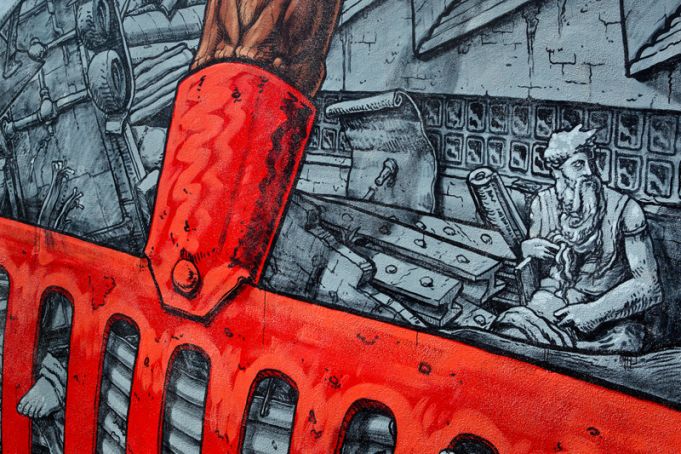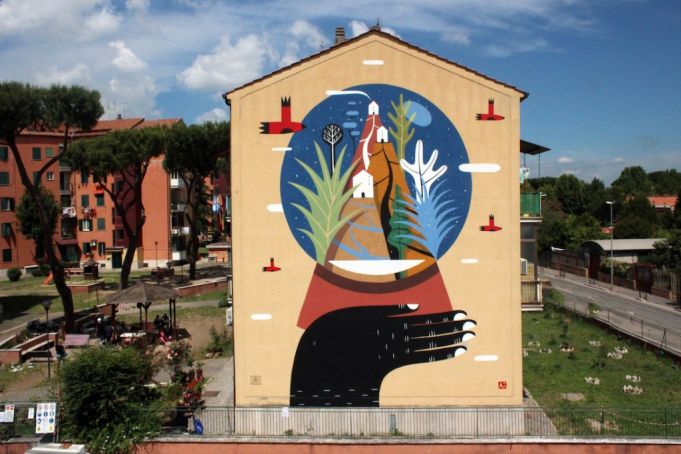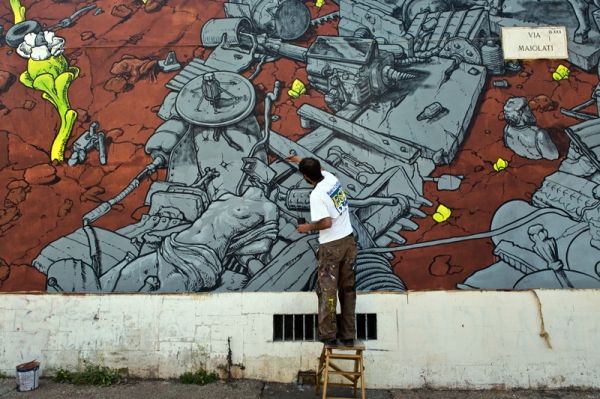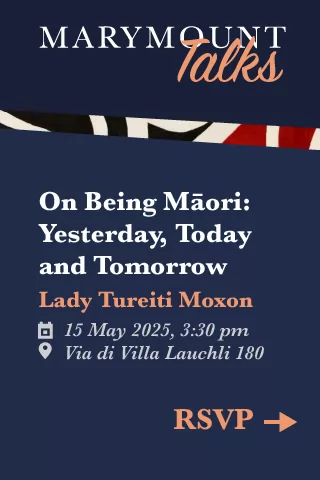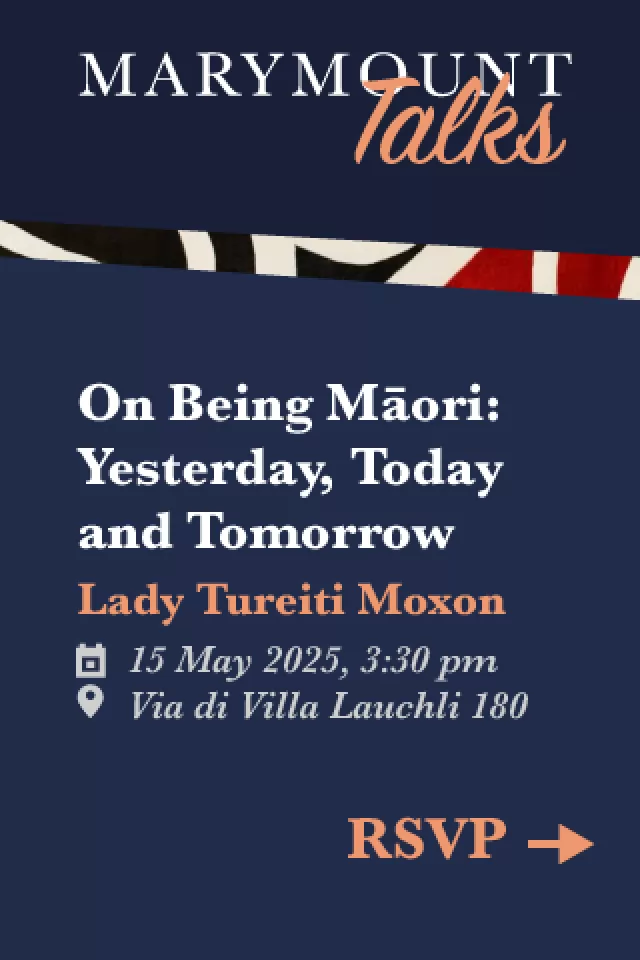Public art is central to urban regeneration in Rome's S. Basilio district.
Although better known around the world for its church frescoes, Rome is once again leading the charge in a modern-day renaissance of urban art on the capital's streets.
Residents of districts such as Ostiense, Testaccio, Prenestino, S. Lorenzo and Garbatella will attest to the continuing explosion of street art, much of it bouncing off walls with vibrant colours and avant-garde designs. The growing number of designs being created by the world's leading street artists – with the city's firm approval – is helping to boost Rome's street cred as an important hub for European street art, along with Berlin, Paris and Madrid.
This new generation of murals should not be viewed as “street art” in the underground style of Banksy; rather they are “public art”, the result of successful collaboration between the artist, the area and its residents.
Central to the movement in Rome is WALLS, an association that promotes the value of street art and the right of artists to decorate public spaces (see Wanted in Rome article December 2013). Founded in 2008, the group has overseen numerous private and public projects in diverse locations around the capital, from children's hospitals to universities and jails.
Earlier this summer it was the driving force behind SanBa, a scheme designed to regenerate S. Basilio, a north-east Rome suburb more associated with crime than culture.
The central idea of the project was to enliven this disadvantaged urban area with the help of permanent art installations by two young, internationally-recognised street artists: Italy's Agostino Iacurci and Spain's Liqen. Both artists each completed two gigantic murals on four buildings made available to them by municipal housing body ATER Roma, breathing new life into an otherwise forgotten neighbourhood.
Located in the shadow of Rebibbia prison, the entire district shows signs of neglect and poverty, making the monumental SanBa murals all the more important, and indeed unexpected.
Perhaps the most spectacular of them is El Devenir, featured on the September edition of Wanted in Rome, a hugely colourful vision of blossoming flowers, complete with beetle and dragonfly and many other creatures not instantly familiar. Painted on the gable wall of a four-storey block of flats at the corner of Via Fabriano, the mural looms above abandoned crashed cars and elderly residents playing cards in their gardens below.
Testifying to S. Basilio's tattered reputation, directly across the road is an unrelated piece of art work: a memorial to a local man shot dead over a traffic dispute last year, in a case which catapulted the district into the headlines again for all the wrong reasons. Unlike the joy of Devenir, this menacing mural features hooded, masked ultra football fans and a pit bull.
The mood picks up again further down Via Fabriano with another eye-catching and powerful work by Liqen. Titled El Renacer (meaning “to be born again” in Spanish), it shows a red rake uprooting a monotone civilisation, spanning from ancient Rome to today's technological age, allowing fresh new shoots to sprout up through the fertile soil.
From a distance the mural seems relatively simplistic; it is only on closer inspection that the staggering level of detail can be appreciated. Ruined buildings and squashed machinery jostle with Roman soldiers on horseback and crumbling towers. Michelangelo's statue of Moses even makes an appearance.
Towards the end of the street in the direction of the jail is Iacurci's The Blind Wall, which featured as the cover of the August edition of Wanted in Rome. Born in Foggia near the Adriatic Sea, the 28-year-old artist is already well known to many Romans, thanks in particular to The Swimmer, his image of a jolly bather near Ostiense train station.
Iacurci's mural on the corner of Via Fabriani is painted in his distinctive style, which relies on large areas of flat colour, and is more concise and stylised in comparison to Liqen. The image shows an elderly man with a white beard and a watering can in a garden under a starry night sky. At the base of the mural is a large roughly-mown green area – far less attractive than the vision above it.

Iacurci's second SanBa mural The Globe can be found at the opposite end of Via Recanati, which runs parallel to Via Fabriano. The minimalist image shows a hand cradling a glass ball containing a miniature natural world, surrounded by flying red birds. It too is painted in crisp lines and solid colours, and provides an uplifting feel to a street synonymous with drug dealing.
During the two-month-long project, the artists engaged with the local community by holding meetings to explain the SanBa theme behind their designs, namely to give a positive message with hope for the future. In return, residents offered the artists lunches and coffees, as well as talking to them while they worked.
It was Liqen's first time making his mark in Rome and he lived in S. Basilio for the duration of the project, to get a better feel for the area. The level of hospitality afforded to him by locals is evident in his thanks to the “signore del pranzo” at the bottom left of Devenir. Born in Vigo in 1980, Liqen is based primarily in Mexico and is best known for his hugely detailed and highly imaginative murals around the world, from Latin America to Europe.
Iacurci on the other hand is no stranger to the area. In 2011 he completed the project Punti di fuga (vanishing points) at Rebibbia prison. Curated by WALLS, the murals were painted in collaboration with a group of 15 inmates in the courtyard of the jail's maximum security unit. Each of the prisoners contributed ideas for the composition, leading to the creation of a surreal, dreamlike landscape of people and exotic animals.
By the time SanBa ended on 30 May it had turned into a sort of festival, with pupils from several local primary and secondary-level schools becoming involved in painting, writing and film workshops based around the murals. The students even created a timber art installation representing an imaginary metro stop called SanBa, highlighting the desire of local residents to be better connected to the city centre.
Simone Pallotta, the head of WALLS and curator of SanBa, described the project as "public art in the true sense of the word, that allows local residents to play an active role." Pallotta said his association's goal is to carry out similar projects in other areas “where they are needed”, adding: “Our hope is to nurture troubled neighbourhoods by creating new tourist flows from the centre out to the suburbs."
His vision is seconded by Rome's councillor for the development of the suburbs, Paolo Masini, who said SanBa represents “an important step in the work we are doing in [regenerating] our suburbs, which begins with street art.”
The project was also backed by the cultural association Fondazione Roma-Arte-Musei whose president Emmanuele F. M. Emanuele said there was no such thing as “Serie A or Serie B citizens, just a communal body of people, and we need to create exchange between all sections of the city.”
All four murals are within about a five minute walk of each other and are absolutely worth the hike out of town, even if Metro SanBa is make-believe.
Andy Devane
This article was published in the 10 September 2014 edition of Wanted in Rome, before the project was completed by Hitnes the following February. See update.
SIDE NOTES
Getting to S. Basilio by public transport
Take the Metro B to the end of the line, at Rebibbia. Cross the street from the station and catch the 343 or 344 bus as far as the Casale S. Basilio/Sarnano stop. From here you can easily visit all four murals on nearby Via Recanati and Via Fabriano.
To learn more about Agostino Iacurci see his website.
To see Liqen's work visit his website.
For more information on WALLS see its website.



